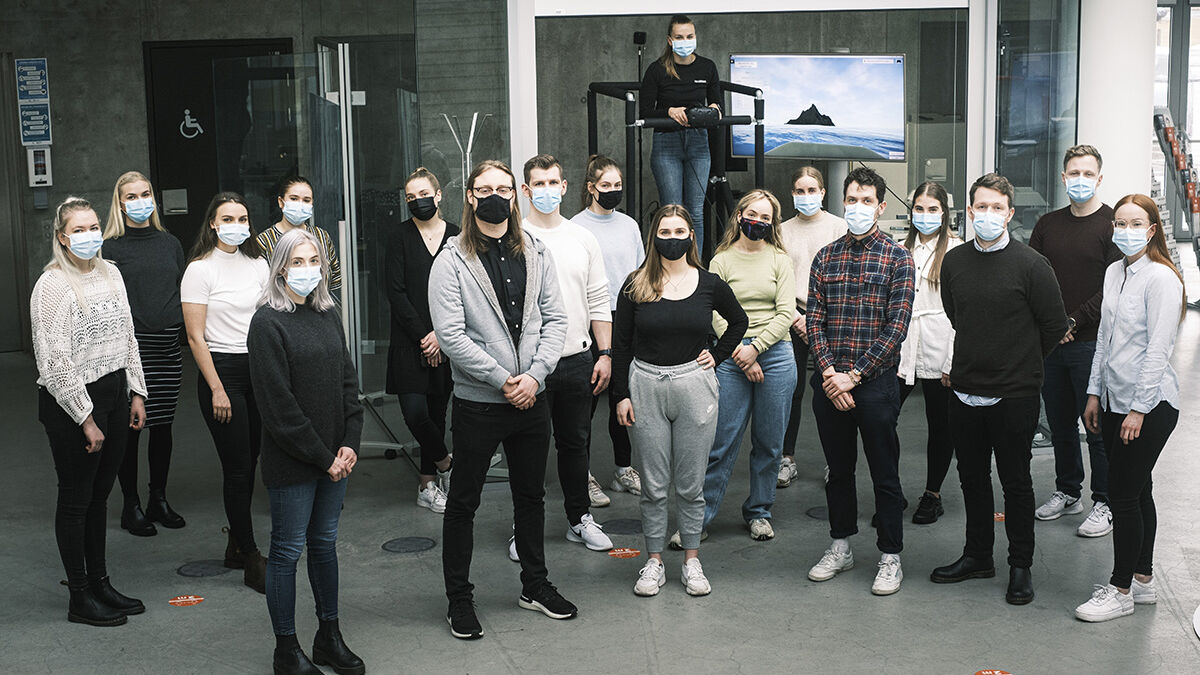"I don´t get seasick myself!"
A group of students in their final year of BSc studies in Biomedical Engineering recently co-wrote a scientific article about their research that was published in the research journal Frontiers in Bioengineering and Biotechnology. It is rare for undergraduate students to achieve such results in research.
"I knew almost nothing about motion sickness as I do not get car sickness or seasickness myself! However, I have now gotten to know it on a large scale after seeing so many people participate in our study. It has also been very interesting to work with the data and see what actually happens in our body when people experience motion sickness," says Valdís Bæringsdóttir, one of the students who co-wrote the article.
 The students who participated in the course Measurement Technology and Vital Signs, and collected data that will be used in the future in the development of treatment for motion sickness. Co-authors of the article are at the front of the picture, from left: Deborah Jacob, Marco Recenti, Sólveig Agnarsdóttir, Romain Aubonnet, Gunnar Hákon Karlsson, and Valdís Bæringsdóttir.
The students who participated in the course Measurement Technology and Vital Signs, and collected data that will be used in the future in the development of treatment for motion sickness. Co-authors of the article are at the front of the picture, from left: Deborah Jacob, Marco Recenti, Sólveig Agnarsdóttir, Romain Aubonnet, Gunnar Hákon Karlsson, and Valdís Bæringsdóttir.
Researching motion sickness with virtual reality
The students thus had a large input in an extensive research project that assesses the biological aspects of motion sickness. The aim is to increase understanding of its causes, which in turn may enable us to reduce the symptoms of motion sickness in the near future.
"We were actually the first participants in the first prototype of the study. I then continued to work on it with Halldór and Sólveig the following summer when we received funding for it. During the summer we set up a synchronised system of measuring instruments for the study and received the first 110 participants," says Valdís.
The study was conducted through virtual reality on a platform that moves and mimics the waves that participants see in virtual reality glasses. You can simulate situations at sea, while driving, flying and more. During the participants' experience of the wave movements, measurements were made with electroencephalogram, heart rate measurements, electromyography, oxygen saturation measurements and posture. Valdís says the measurements themselves have been exciting: "Yes, I enjoyed getting to know all the biological measuring instruments we use in the study, how they work and how the data obtained from them are processed." Participants also answered short questionnaires about their health and susceptibility to motion sickness.
Collaboration between three universities
This new high-tech equipment for research was made available a year ago in the main hall of Reykjavík University (RU), the Sun. The development of the research facility is a joint project of the RU's Institute of Biomedical Engineering, the University of Iceland and the University of Akureyri. This is the first article to be published on the results of research conducted within the new centre.
Valdís graduated with a BSc in health engineering last spring and will graduate this spring with a BSc in computer science. She is aiming for further studies where she can mix these two disciplines.
The name of the article is: Towards predicting Motion Sickness using Virtual Reality and a Moving Platform Assessing Brain, Muscles, and Heart signals and is in the journal Frontiers in Bioengineering and Biotechnology, section: Biomechanics.
The authors of the article are: Marco Recenti, Carlo Ricciardi, Romain Aubonnet, Ilaria Picone, Deborah Jacob, Halldór Ásgeir Risten Svansson, Sólveig Agnarsdóttir, Gunnar Hákon Karlsson, Valdis Baeringsdóttir, Hannes Petersen and Paolo Gargiulo .

